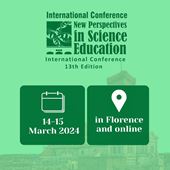Applying the 'Models Of' versus 'Models For' Heuristic to Support Teachers’ Learning of Modelling Practices used in Molecular Biology Research
Amber Cesare, The Pennsylvania State University (United States)
Kathleen Hill, The Pennsylvania State University (United States)
Neela Yennawar, The Pennsylvania State University (United States)
Hemant Yennawar, The Pennsylvania State University (United States)
Amie Boal, The Pennsylvania State University (United States)
Cody Lloyd, The Pennsylvania State University (United States)
Abstract
The Next Generation Science Standards (NGSS) were published to move science education towards instruction that is rich in content and practice across disciplines. NGSS expects K-12 science teachers to use the practices of scientists to teach disciplinary core ideas (NRC, 2012; NGSS Lead States, 2013). One challenge to translating the NGSS to the classroom is the lack of resources and programs that model and feature the science practices (Bybee & Chopyak, 2017). The SHAPE MATTERS program is funded by the National Institute of Health; one of its goals is to increase teachers’ knowledge of scientific practices involved in molecular biology research. The program used molecular stories, around diabetes, to engage teachers in “Modelling of” and “Modelling for”, because using only “models of” creates a false sense that models are merely representations of the real thing rather than for posing questions and generating and refining knowledge (Gouvea & Passmore, 2017).
At the professional development, teachers learned how the structures of proteins are determined using x-ray crystallography, and how scientists make decisions based on data to generate a 3D model of a protein. This model is published in a freely accessible public database, the Protein Data Bank (PDB). Using various PDB insulin files, teachers used JUDE, a molecular visualization program, to examine the active form of insulin, the monomer. Then, teachers looked at the dimer, and finally how insulin was stored as a hexamer. The workshop culminated with a JUDE investigation looking at different designer insulins to answer structure-function questions about how insulin was altered to control blood sugar in diabetes. Teachers were given a modified version of the Students’ Understanding of Models in Science instrument (Treagust et al., 2002) as a pre/post test. In cohort 1, multiple participants reported that they agreed or strongly agreed that models were exact replicas. Due to this finding, we altered the workshop in the following years to further highlight uncertainty. Cohorts 2 and 3 had the largest pre-post difference for the Models as Exact Replicas. This difference suggests that the changes made due to the evaluation data had a greater impact on participants’ understanding.
|
Keywords |
Teacher professional development, Modelling, Molecular Biology, Science Practices |
|
REFERENCES |
Bybee, R. & Chopyak, C. (2017). Instructional Materials and Implementation of Next Generation Science Standards: Demand, Supply, and Strategic Opportunities. Carnegie Corporation of New York. Gouvea, J. & Passmore, C. (2017). ‘Models of’ versus ‘Models For’: Toward an Agent-Based Conception of modelling in the Science Classroom. Science & Education, 26, 49-63. National Research Council (NRC). (2012). A Framework for K-12 Science Education Practices, Crosscutting Concepts, and Core Ideas. Washington, D.C.: The National Academies Press. NGSS Lead States. (2013). Next Generation Science Standards: For states, by states. Washington D.C.: The National Academies Press. Treagust, D.F., Chittleborough, G., & Mamiala, T.L. (2002). Students’ understanding of the role of scientific models in learning science. International Journal of Science Education, 24(4), 357-368.
|
 New Perspectives in Science Education
New Perspectives in Science Education





























